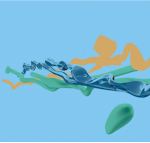| The event was co-produced by Rupriikki Media Museum. Photo from their new exhibition “Weaving a net – the history of the Internet”. The Photo is published on the Rupriikki web site |
Part of manSEDANse festival was an interesting lecture about the bad features of our dear friend: The Internet. Despite being held on a Wednesday evening the lecture attracted an audience of some 20 people. Unfortunately the lecture was held in Finnish.
Here are the main points Susanna Paasonen, a media researcher from the University of Jyväskylä, had.
Paasonen began with the popularization of Internet in the 90s and raised questions about Internet’s metaphoric nature: What is really Internet? Servers, protocols, user culture? In the 90s sci-fi lingo was favored when talking about Internet, since it was –and still is- considered a cyber space of some sort. Fashionable words like Information society Information technology set interesting frames to defining the usage of Internet.
Internet has it’s positive sides in serving the Information world: it makes dealing with bureaucracy easier. On the other hand it has a lot of “useless” usage too. What do people really use Internet for, what is and has been the role of Internet at homes? One particularly interesting question is: Since everything from bank affairs to book reservations and study calendars is done online, can you not use the Internet?
The uncontrollable nature of Internet brings along threats that Paasonen unveiled. Here are the biggest threats according to her studies:
- Addiction. How often do you read your email, use Facebook etc.? On the other hand, if your computer is on and you have Facebook open, does that constitute as Facebook usage? And if you use your email to handle business, can active checking be something else than a sign of addiction? In my opinion one aspect that matters is also the fact that how important the usage is to you: whether you can or cannot cope without the Internet.
- Viruses. Along with spreading information, the Internet spreads all kinds of filth that contaminates our systems and controls our computers.
- Paedophilia, childporn. Though most of sexual abuse cases of children are conducted by family members or other close people, Internet has become the main target on this issue. Tabloids exploit Internet’s reputation in this matter. Subjects such as pedobear and different memes are popular and easy to spread over the Internet. It is also important to think about what children themselves find on-line.
- Porn, especially home porn. The conventional porn industry is doing not so well since amateurs have easy access to content. Subcultures and fetishes have become more visible and porn is fragmenting over the Internet. Sites can be dedicated to almost anything, though censorship and moderation tries to clean out the most violate ones.
- 3rd person effect is a popular phenomenon concerning Internet. Everyone is always worried about someone other than themselves – usually children. Many companies take advantage of this by offering childproof programs such as Safe Eyes, Safe Vision and MyKids Browser. Of course these filters don’t solve all of the problems concerning unwanted material.
The author is Degree Programme in Media student
|||

 Suomeksi
Suomeksi








